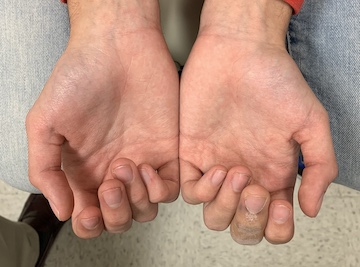Last updated on December 19, 2019
Fingers are not parallel. When each finger is flexed in isolation, it points (roughly) to the distal pole of the scaphoid. This is only possible if the fingers are not parallel – there must be some overlap of the tips of the fingers for this to be true.
Video by Grant Thomson licensed under CC BY-NC-SA 4.0
When the fingers flex together (as when making a fist), pressure from an adjacent finger will push the fingers into alignment, and they will appear to be parallel when they touch the palm. This motion does not accurately reflect the true alignment of the fingers, and malrotation can be missed, or malrotation can falsely be ascribed.
Video by Grant Thomson licensed under CC BY-NC-SA 4.0
Example of falsely diagnosing malrotation
This patient has a minor injury to the middle finger causing swelling and stiffness. The examiner assessed for malrotation by asking him to make a fist and comparing both hands. The finger does not flex completely, and it appears malrotated when compared to the normal hand.

However, if one asks the patient to display his digital cascade with the fingers semi-flexed, and allows them to overlap normally (this may require the examiner to adjust the fingers manually, as patients tend to try to make their fingers parallel when asked to do this, and pain can also inhibit the patient’s ability to comply), one can see that the alignment is symmetrical, and one can even quantitate the amount of overlap (in this case, the middle finger overlaps the ring finger by 50% of the nail). There is no malrotation.

